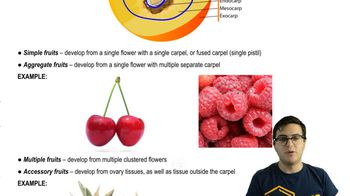Table of contents
- 1. Introduction to Biology2h 42m
- 2. Chemistry3h 40m
- 3. Water1h 26m
- 4. Biomolecules2h 23m
- 5. Cell Components2h 26m
- 6. The Membrane2h 31m
- 7. Energy and Metabolism2h 0m
- 8. Respiration2h 40m
- 9. Photosynthesis2h 49m
- 10. Cell Signaling59m
- 11. Cell Division2h 47m
- 12. Meiosis2h 0m
- 13. Mendelian Genetics4h 44m
- Introduction to Mendel's Experiments7m
- Genotype vs. Phenotype17m
- Punnett Squares13m
- Mendel's Experiments26m
- Mendel's Laws18m
- Monohybrid Crosses19m
- Test Crosses14m
- Dihybrid Crosses20m
- Punnett Square Probability26m
- Incomplete Dominance vs. Codominance20m
- Epistasis7m
- Non-Mendelian Genetics12m
- Pedigrees6m
- Autosomal Inheritance21m
- Sex-Linked Inheritance43m
- X-Inactivation9m
- 14. DNA Synthesis2h 27m
- 15. Gene Expression3h 20m
- 16. Regulation of Expression3h 31m
- Introduction to Regulation of Gene Expression13m
- Prokaryotic Gene Regulation via Operons27m
- The Lac Operon21m
- Glucose's Impact on Lac Operon25m
- The Trp Operon20m
- Review of the Lac Operon & Trp Operon11m
- Introduction to Eukaryotic Gene Regulation9m
- Eukaryotic Chromatin Modifications16m
- Eukaryotic Transcriptional Control22m
- Eukaryotic Post-Transcriptional Regulation28m
- Eukaryotic Post-Translational Regulation13m
- 17. Viruses37m
- 18. Biotechnology2h 58m
- 19. Genomics17m
- 20. Development1h 5m
- 21. Evolution3h 1m
- 22. Evolution of Populations3h 52m
- 23. Speciation1h 37m
- 24. History of Life on Earth2h 6m
- 25. Phylogeny2h 31m
- 26. Prokaryotes4h 59m
- 27. Protists1h 12m
- 28. Plants1h 22m
- 29. Fungi36m
- 30. Overview of Animals34m
- 31. Invertebrates1h 2m
- 32. Vertebrates50m
- 33. Plant Anatomy1h 3m
- 34. Vascular Plant Transport1h 2m
- 35. Soil37m
- 36. Plant Reproduction47m
- 37. Plant Sensation and Response1h 9m
- 38. Animal Form and Function1h 19m
- 39. Digestive System1h 10m
- 40. Circulatory System1h 57m
- 41. Immune System1h 12m
- 42. Osmoregulation and Excretion50m
- 43. Endocrine System1h 4m
- 44. Animal Reproduction1h 2m
- 45. Nervous System1h 55m
- 46. Sensory Systems46m
- 47. Muscle Systems23m
- 48. Ecology3h 11m
- Introduction to Ecology20m
- Biogeography14m
- Earth's Climate Patterns50m
- Introduction to Terrestrial Biomes10m
- Terrestrial Biomes: Near Equator13m
- Terrestrial Biomes: Temperate Regions10m
- Terrestrial Biomes: Northern Regions15m
- Introduction to Aquatic Biomes27m
- Freshwater Aquatic Biomes14m
- Marine Aquatic Biomes13m
- 49. Animal Behavior28m
- 50. Population Ecology3h 41m
- Introduction to Population Ecology28m
- Population Sampling Methods23m
- Life History12m
- Population Demography17m
- Factors Limiting Population Growth14m
- Introduction to Population Growth Models22m
- Linear Population Growth6m
- Exponential Population Growth29m
- Logistic Population Growth32m
- r/K Selection10m
- The Human Population22m
- 51. Community Ecology2h 46m
- Introduction to Community Ecology2m
- Introduction to Community Interactions9m
- Community Interactions: Competition (-/-)38m
- Community Interactions: Exploitation (+/-)23m
- Community Interactions: Mutualism (+/+) & Commensalism (+/0)9m
- Community Structure35m
- Community Dynamics26m
- Geographic Impact on Communities21m
- 52. Ecosystems2h 36m
- 53. Conservation Biology24m
36. Plant Reproduction
Seeds
Problem 7`
Textbook Question
The black dots that cover strawberries are actually fruits formed from the separate carpels of a single flower. The fleshy and tasty portion of a strawberry derives from the receptacle of a flower with many separate carpels. Therefore, a strawberry is:
a. A simple fruit with many seeds
b. Both a multiple fruit and an accessory fruit
c. Both a simple fruit and an aggregate fruit
d. Both an aggregate fruit and an accessory fruit
 Verified step by step guidance
Verified step by step guidance1
Understand the definition of an aggregate fruit: It is formed from a single flower with multiple carpels, each developing into a small fruit. The black dots on strawberries are the individual fruits from separate carpels, indicating an aggregate fruit.
Recognize the definition of an accessory fruit: It is a fruit where some of the flesh is derived not from the ovary but from some adjacent tissue exterior to the carpel. In strawberries, the fleshy part is derived from the receptacle, making it an accessory fruit.
Analyze the options: A simple fruit develops from a single carpel or several fused carpels, which does not apply to strawberries. A multiple fruit forms from a cluster of flowers, which also does not apply.
Eliminate incorrect options: Option a is incorrect because strawberries are not simple fruits. Option b is incorrect because strawberries are not multiple fruits. Option c is incorrect because strawberries are not simple fruits.
Conclude with the correct option: Based on the definitions and analysis, the correct answer is d, as strawberries are both aggregate fruits and accessory fruits.
 Verified video answer for a similar problem:
Verified video answer for a similar problem:This video solution was recommended by our tutors as helpful for the problem above
Video duration:
3mPlay a video:
Was this helpful?
Key Concepts
Here are the essential concepts you must grasp in order to answer the question correctly.
Aggregate Fruit
An aggregate fruit develops from a single flower that has multiple carpels, each forming a small fruitlet. These fruitlets cluster together to form the entire fruit. Strawberries are an example, where each black dot on the surface is an individual fruitlet, making the strawberry an aggregate fruit.
Recommended video:
Guided course

Fruit
Accessory Fruit
An accessory fruit is one where some of the flesh is derived not from the ovary but from some adjacent tissue exterior to the carpel. In strawberries, the fleshy part we eat is derived from the receptacle of the flower, not the ovaries, classifying it as an accessory fruit.
Recommended video:
Guided course

Fruit
Carpel
A carpel is the female reproductive part of a flower, consisting of an ovary, a stigma, and usually a style. In strawberries, each carpel develops into a small individual fruit, which is why the surface of a strawberry is covered with tiny, seed-like structures, each representing a separate carpel's fruit.
Recommended video:
Guided course

Fruit
Related Videos
Related Practice




















